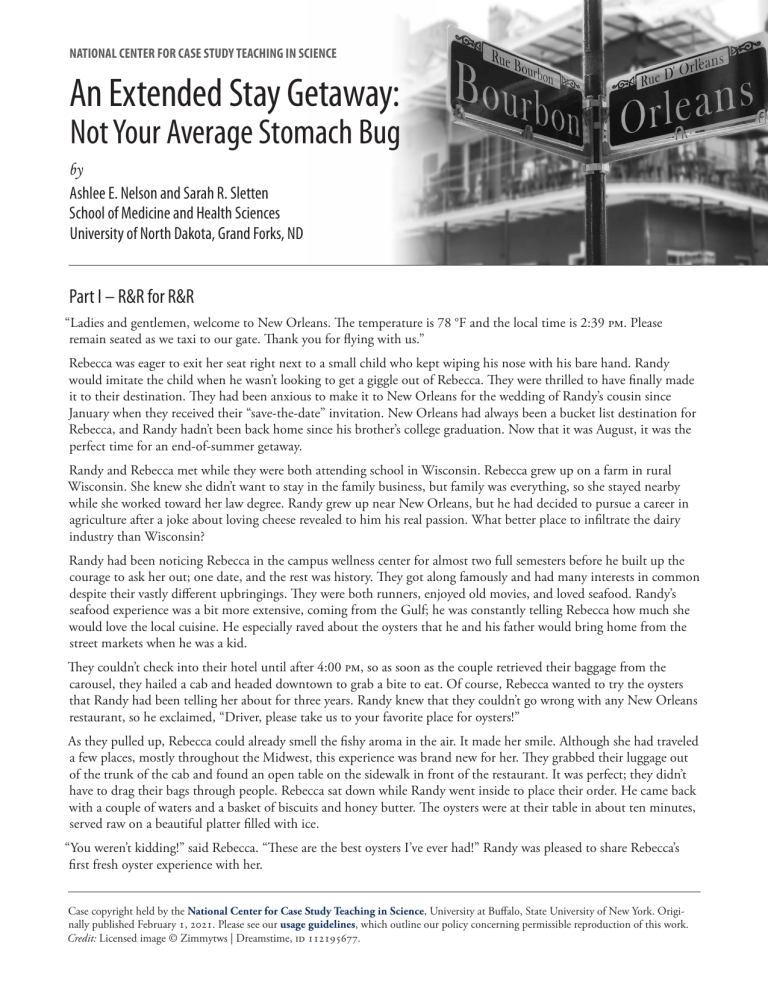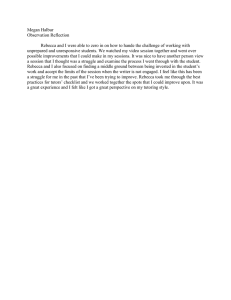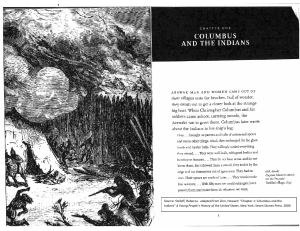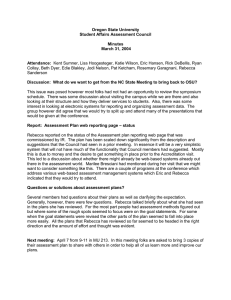
NATIONAL CENTER FOR CASE STUDY TEACHING IN SCIENCE An Extended Stay Getaway: Not Your Average Stomach Bug by Ashlee E. Nelson and Sarah R. Sletten School of Medicine and Health Sciences University of North Dakota, Grand Forks, ND Part I – R&R for R&R “Ladies and gentlemen, welcome to New Orleans. The temperature is 78 °F and the local time is 2:39 pm. Please remain seated as we taxi to our gate. Thank you for flying with us.” Rebecca was eager to exit her seat right next to a small child who kept wiping his nose with his bare hand. Randy would imitate the child when he wasn’t looking to get a giggle out of Rebecca. They were thrilled to have finally made it to their destination. They had been anxious to make it to New Orleans for the wedding of Randy’s cousin since January when they received their “save-the-date” invitation. New Orleans had always been a bucket list destination for Rebecca, and Randy hadn’t been back home since his brother’s college graduation. Now that it was August, it was the perfect time for an end-of-summer getaway. Randy and Rebecca met while they were both attending school in Wisconsin. Rebecca grew up on a farm in rural Wisconsin. She knew she didn’t want to stay in the family business, but family was everything, so she stayed nearby while she worked toward her law degree. Randy grew up near New Orleans, but he had decided to pursue a career in agriculture after a joke about loving cheese revealed to him his real passion. What better place to infiltrate the dairy industry than Wisconsin? Randy had been noticing Rebecca in the campus wellness center for almost two full semesters before he built up the courage to ask her out; one date, and the rest was history. They got along famously and had many interests in common despite their vastly different upbringings. They were both runners, enjoyed old movies, and loved seafood. Randy’s seafood experience was a bit more extensive, coming from the Gulf; he was constantly telling Rebecca how much she would love the local cuisine. He especially raved about the oysters that he and his father would bring home from the street markets when he was a kid. They couldn’t check into their hotel until after 4:00 pm, so as soon as the couple retrieved their baggage from the carousel, they hailed a cab and headed downtown to grab a bite to eat. Of course, Rebecca wanted to try the oysters that Randy had been telling her about for three years. Randy knew that they couldn’t go wrong with any New Orleans restaurant, so he exclaimed, “Driver, please take us to your favorite place for oysters!” As they pulled up, Rebecca could already smell the fishy aroma in the air. It made her smile. Although she had traveled a few places, mostly throughout the Midwest, this experience was brand new for her. They grabbed their luggage out of the trunk of the cab and found an open table on the sidewalk in front of the restaurant. It was perfect; they didn’t have to drag their bags through people. Rebecca sat down while Randy went inside to place their order. He came back with a couple of waters and a basket of biscuits and honey butter. The oysters were at their table in about ten minutes, served raw on a beautiful platter filled with ice. “You weren’t kidding!” said Rebecca. “These are the best oysters I’ve ever had!” Randy was pleased to share Rebecca’s first fresh oyster experience with her. Case copyright held by the National Center for Case Study Teaching in Science, University at Buffalo, State University of New York. Originally published February 1, 2021. Please see our usage guidelines, which outline our policy concerning permissible reproduction of this work. Credit: Licensed image © Zimmytws | Dreamstime, id 112195677. NATIONAL CENTER FOR CASE STUDY TEACHING IN SCIENCE Once they were finished, they went and settled into their hotel to rest up before the wedding festivities the next day. They found the original James Bond movie on cable and started to doze off. The next day was the wedding. The couple was so excited to celebrate the newlyweds. Rebecca and Randy loved a good party and were ready to cut a rug with friends and family. “Mmmmm, this prime rib is incredible!” Randy said. They were assigned to sit with his family. It was Rebecca’s first time meeting them all. Randy’s mom replied, “Even this salad is good! Nothing like a good wedding meal.” Rebecca quietly drank her wine, as she was a little intimidated to be meeting everyone. Shortly after supper, all the guests joined in a champagne toast for the bride and groom. After the glass of champagne and another round of drinks, Rebecca was chatting with the whole table. Then the music started, and they danced the whole time. Randy’s family loved Rebecca and were happy he had found such a sweet girl. The DJ played the last song at midnight. Every guest was exhausted as they said their goodbyes. Randy and Rebecca went straight back to the hotel and fell fast asleep. At about 2:00 am, Rebecca woke up with a chill. Her stomach was cramping and gurgling. She rushed to the restroom, trying not to waken Randy. She splashed her face with some water and then stood for a moment with the hot water running over her hands, in hopes of warming up. In an instant, she was experiencing diarrhea like never before. When she felt she could go back to bed, she crawled under the sheets slowly, still trying not to disrupt Randy. About an hour later, Rebecca again woke up, but this time the cramps were worse, and she was covered in cold sweat. The abdominal cramps were too much to bear and she let out a yell. Randy woke up startled. It didn’t take him long to realize the yell had come from Rebecca. Randy noticed that his stomach hurt as well, but his attention was on Rebecca. She was beginning to walk toward the bathroom again. As Randy got up to help her and ask her what was going on, she fell to the floor. She had fainted. She came to quickly, but Randy was already on the phone with an ambulance. Rebecca, stubborn as she was, insisted she would be okay and that it was just a bug, but Randy wasn’t taking any chances. They got situated in a hospital room and Rebecca was started on IV fluids. Questions 1. If both Rebecca and Randy have fallen ill, what are some possible sources for their sickness? 2. Based on the symptoms stated, which body system is most likely affected? 3. Which preliminary tests should be run to identify a diagnosis? “An Extended Stay Getaway” by Nelson and Sletten Page 2 NATIONAL CENTER FOR CASE STUDY TEACHING IN SCIENCE Part II – Off to the Lab Rebecca was running a fever of 101.4 °F and had begun throwing up. The nurses provided her with some anti-nausea medication and took blood and stool samples for analysis. While waiting for the lab results, the nurses conducted a short interview to investigate what could be causing the discomfort and violent gastrointestinal reaction. The following remarks were made in her chart. Patient history: Female. 32 years old. Partner indicated that patient was diagnosed with rheumatoid arthritis four years ago. Patient maintains regular injection schedule. Standing prescription for adalimumab. Symptoms: • T 38.6 °C; BP 95/50 mmHg; P 135/min • Emesis • Severe fatigue • Abdominal pain • No coughing or wheezing Complete Blood Count (CBC) with Differential: • Hematocrit: 42.9% (Normal range for women: 34.9 to 44.5%) • Platelets: 115,000 µL (Normal range for women: 150,000 to 450,000/µL) • Leukocyte count: 14,000/µL (Normal range: 4,500 to 11,000/µL) • Differential leukocytes: 75% PMNs, 3% monocytes, 20% lymphocytes, 1% eosinophils, 1% basophils Microbiology: • Stool culture: growth on MacConkey (MAC) thiosulfate citric bile salt sucrose (TCBS) agar after 24-hour incubation (Figure 1). • Blood cultures: detected microbial growth after 36hour incubation, • Gram stain: A follow-up Gram stain was prepared on positive blood culture bottle (Figure 2). Questions 4. Interpret the stool culture. Figure 1. Stool samples cultured on A) MAC agar and B) TCBS agar. [1] 5. Interpret the Gram stain. 6. Discuss possible diagnoses for Rebecca. 7. What is the most likely source of infection? “An Extended Stay Getaway” by Nelson and Sletten Figure 2. Gram stain of blood culture sample. [2] Page 3 NATIONAL CENTER FOR CASE STUDY TEACHING IN SCIENCE Part III – The Disease and Pathogenesis After careful examination of Rebecca’s history, signs and symptoms, and together with the lab results, the doctors diagnosed her with gastroenteritis and septic shock due to Vibrio vulnificus, otherwise known as vibriosis, a rare, yet serious condition. In addition to the fluids she was given to keep her hydrated and stable, they started her on a treatment of cephalosporin antibiotics to inhibit bacterial growth. Rebecca was monitored in the hospital. Repeat blood cultures were obtained on the third day and indicated that pathogenic bacterial load was significantly diminished. After one extra day of observations, Rebecca and Randy were sent home. They were told to keep an eye on physical symptoms such as dizziness and fatigue but that she should feel back to herself in a short time with little chance of long-term side effects. Questions: 8. Briefly describe how each of the following defense mechanisms works to aid V. vulnificus in infecting the host. a. Acid resistance: b. Capsular polysaccharide: c. Cytotoxicity: d. Others: 9. If Rebecca and Randy consumed the same oysters, why was Rebecca the only one who got vibriosis? What are some possible explanations? “An Extended Stay Getaway” by Nelson and Sletten Page 4 NATIONAL CENTER FOR CASE STUDY TEACHING IN SCIENCE Part IV – The Epidemiology Vibriosis is a nationally notifiable disease, which means it is reported to local health departments and the CDC upon diagnosis. This allows public health workers to monitor the cases and data for any possible patterns or trends. Epidemiology is the branch of medicine that deals with the incidence, distribution, and possible control of diseases. Consider the following example of an epidemiological (epi) curve which is representative of vibriosis cases that one might expect to see along the Gulf coast near New Orleans (Figure 3). Figure 3. Example epi curve using data adapted from CDC case reports of vibriosis cases in the United States. Each bar represents one month. The y-axis is the raw number of cases. [3] Questions 10. What trend(s) can be identified in the data? 11. What possible factors could explain the trend(s) identified in the data? “An Extended Stay Getaway” by Nelson and Sletten Page 5 NATIONAL CENTER FOR CASE STUDY TEACHING IN SCIENCE Part V – The Ecological Connection Today, Rebecca and Randy are happy and healthy. They were married two years after the vibriosis episode and have been crusaders to promote awareness for global climate change ever since. Question 12. Why would Rebecca’s scare with vibriosis push her and Randy to want to advocate for global climate change awareness? End Notes [1] Figure 1(A) by S. Sletten; Figure 1(B), reproduced with the permission of AIP Publishing, from: Al-Dulaimi, M.M.K., et al. 2014. Isolation and identification among cockle isolates of Vibrio vulnificus isolated from Selangor, Malaysia. AIP Conference Proceedings 1614(1), 208. <https://doi.org/10.1063/1.4895197>. [2] Figure 2, reproduced with permission from BMJ Publishing Group Ltd., from: Hendren, N., et al. 2017. Vibrio vulnificusseptic shock due to a contaminated tattoo. BMJ Case Reports. <https://doi.org/10.1136/bcr-2017-220199>. [3] The actual data used to develop the epi curve in Figure 3 was generated by the authors of this case study using similar outbreaks and is not reflective of actual CDC data for New Orleans, LA. For further information, see “Epi Curve” on the CDC website at <https://www.cdc.gov/vibrio/investigations/vibriop-09-13/epi.html>. “An Extended Stay Getaway” by Nelson and Sletten Page 6


